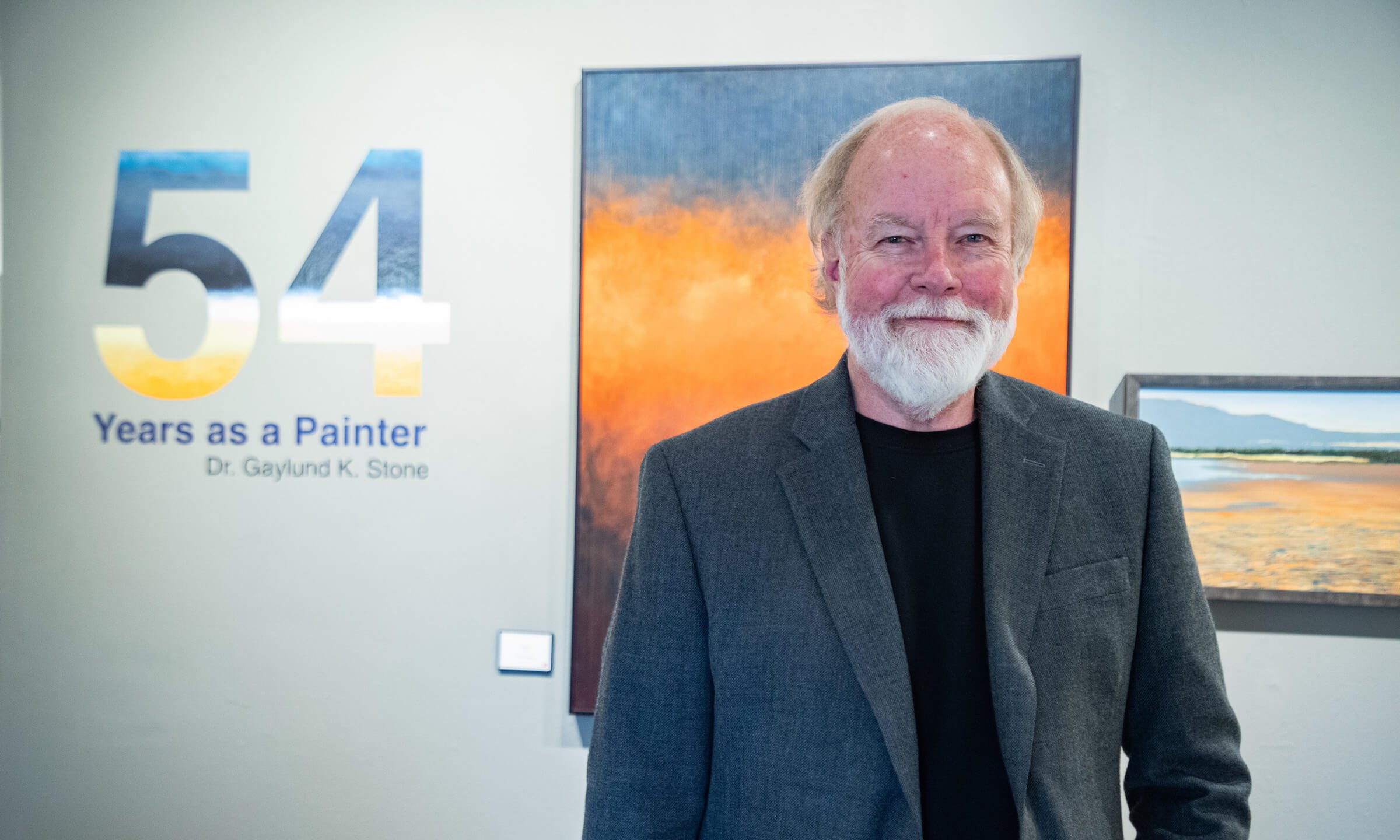
After more than 30 years of service to Concordia, Dr. Gaylund Stone will retire at the end of this academic year. The latest CUW Art Gallery showcases Stone's work, spanning more than 50 years.
Two years into his undergraduate experience at Princeton University, Gaylund Stone did an about face and switched his career trajectory from medicine to art.
Despite the fact that he had accrued enough credits to sit for the medical boards, Stone ultimately came to observe a level of callousness in some doctors that was distasteful to him. No doubt their tendency to put up an emotional wall was a coping mechanism for the work they needed to do, but nevertheless, it soured the career for Stone.
He didn’t let the program switch slow him down, however. In his remaining years at Princeton, he completed a bachelor’s degree in art history and painting and was among the first graduates in the university’s new Creative Arts Program.
Ironically, it would take Stone over a decade longer to infuse emotion into his art.
“For me, my art was about design and doing something different with paint that would get somebody’s attention,” explains Stone. “It wasn’t particularly personal. That was often the approach to painting in the ’70s.”
That abruptly changed in the mid-’80s, following the tragic death of his 8-month-old daughter.
“From that point on, painting was different,” Stone says. “It was more about experience than design.”

54 years as a painter
His emotional shift and the impact it had on Stone’s work is on full display now through April 17 in Concordia University Wisconsin’s Art Gallery. The latest CUW art exhibit features 30 of Stone’s paintings, with the earliest dating back to the late ’60s.
Community members and CUW faculty, staff, students, and alumni alike are invited to view the work at no charge. The Gallery is open:
CUW Art Gallery
Monday-Thursday from 4-8 p.m.
Friday & Sunday from 12-4 p.m.
Admission is free!
A storied career
Following his graduation from Princeton, Stone struck out for the west in his old Chevy with little more than a tent and his art supplies. He deliberately made his way across the country, stopping to take in the sights and to draw and paint. Ultimately, he landed in Oklahoma where he remained for more than a decade, teaching science at the middle school level, art at the high school level and, eventually, art at a local college. Not long after the loss of their daughter, Stone and his wife sought a move closer to her home state of Wisconsin. His father-in-law, Hilbert Hilgendorf, who was serving as Second Vice President of the LCMS South Wisconsin District at the time, tipped him off to an opening at Concordia.
Stone began at Concordia in 1991 as an assistant professor of art and chair of the art department. In 1998, he rose to Dean of the School of Arts and Sciences where he was responsible for hiring many of the faculty who currently instruct at Concordia today.
“During most of my years as dean we were growing so fast,” says Stone. “I spent quite a lot of my time hiring people.”
Stone was also dean at the time of the merger with the Ann Arbor campus.
“I was listening to a pastor who once said, ‘Look for the places where God is working and go there.’ That’s what made the merger with Ann Arbor attractive to me personally. I stayed because change was possible and God was at work…and I loved the students.”
In 2015, he refocused his energy on students in the classroom setting when he stepped away from the deanship and back into his role as chair of the art department.
A summation of Stone’s work
After more than 30 years of service to Concordia, Stone will retire at the end of this academic year. It’s a fitting time, therefore, for a review of his work. His latest gallery showcases pieces that span more than 50 years. Stone calls the gallery “a summary” of his years of painting.
To view the gallery in its fullest, Stone suggests patrons make their way through the space in a clockwise fashion. The paintings are arranged roughly in chronological order to show the progression of his work. Near the center of the gallery is a piece, titled Remembrance, which was directly influenced by his daughter’s passing.
“It’s been hanging in my studio for a long time, but this is the first time I’ve shown it publicly,” says Stone.
Directly following Remembrance is a piece titled, Covenant, which portrays several juniper trees. Stone explains that in much of the west, areas surrounded by clusters of junipers are usually cemeteries. The colors of the trees lend themselves to a rainbow, a symbol of God’s love and provision.
“The loss of our daughter, our first child, was devastating – and yet there was comfort in knowing that she was in God’s hands,” Stone says. “That was a covenant we had with God.”
Explore Concordia’s art programs
Thanks to CUW’s decades-running collaboration with the Milwaukee Institute of Art and Design, students can enroll at Concordia and receive all the benefits of a tight-knit campus community rooted in faith without sacrificing the expertise and industry connections of a MIAD education.
Click on the links below to check out CUW’s joint programs with MIAD:
Concordia also offers the following in-house arts programs:
— This story is written by Kali Thiel. Kali was Director of University Communications until April, 2025.
If this story has inspired you, why not explore how you can help further Concordia's mission through giving.